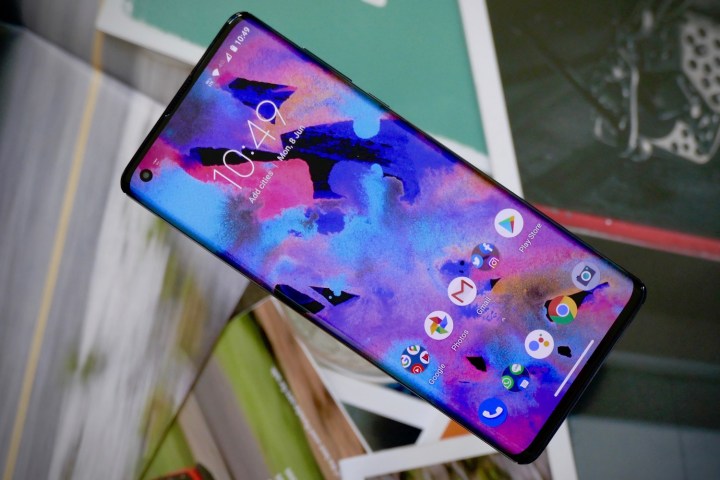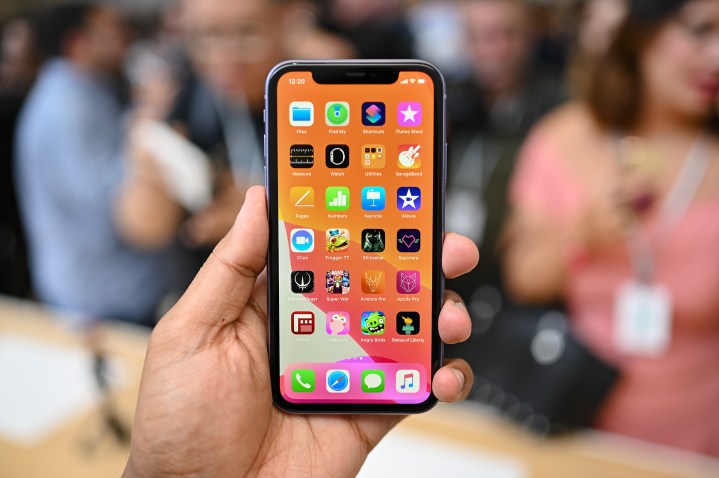If you are looking to get a new smartphone but aren’t interested in shelling out between $900 and $1,000, there are plenty of options for you. However, many people feel like they have to sacrifice a flagship experience by spending less.
Thankfully, that isn’t the case, especially in the Android space. The new Motorola Edge has positioned itself as a flagship killer with excellent specs at an affordable price of $700. However, even Apple has affordable smartphones, with the standard iPhone 11 starting at $699. So which is better? Let’s take a look.
Specs
| Motorola Edge |
iPhone 11 | |
| Size | 161.6 x 71.1 x 9.3mm (6.36 x 2.80 x 0.37 inches) | 150.9 x 75.7 x 8.3mm (5.94 x 2.98 x 0.33 inches) |
| Weight | 188 grams (6.63 ounces) | 194 grams (6.84 ounces) |
| Screen size | 6.7-inch OLED (90Hz) | 6.1-inch Liquid Retina LCD |
| Screen resolution | 2,340 x 1,080 pixels (385 pixels per inch) | 1,792 x 828 pixels (326 pixels per inch) |
| Operating system | Android 10 (under Motorola My UX) | iOS 13 |
| Storage | 128GB | 64GB, 128GB, 256GB |
| MicroSD card slot | Yes | No |
| Tap-to-pay services | Google Pay | Apple Pay |
| Processor | Qualcomm Snapdragon 765G | Apple A13 Bionic |
| RAM | 4GB, 6GB | 4GB |
| Camera | 64-megapixel wide-angle, 16MP ultrawide, 8MP telephoto rear, and time-of-flight depth, 25MP front | Dual lens 12-megapixel and 12MP wide-angle rear, 12MP TrueDepth front |
| Video | Up to 4K at 30 frames per second, 1080p up to 60 fps | 4K at up 60 frames per second, 1080p at 240 fps |
| Bluetooth version | 5.1 | 5.0 |
| Ports | USB-C | Lightning |
| Fingerprint sensor | Yes (under display) | No (Face ID instead) |
| Water resistance | No | IP68 |
| Battery | 4,500mAh
Fast charging (18W) |
Up to 17 hours video playback
Fast charging (18W charger sold separately) Qi wireless charging |
| App marketplace | Google Play Store | Apple App Store |
| Network support | Verizon support coming soon | T-Mobile, AT&T, Verizon, Sprint |
| Colors | Solar Black, Midnight Magenta | Purple, White, Yellow, Green, Black, Red |
| Prices | $700+ | $699 |
| Buy from | Motorola | Apple |
| Review score | 3.5 out of 5 stars | 4 out of 5 stars |
Design, display, and durability

Both phones have solid designs that look and feel premium. The iPhone 11 is made of aluminum with a glossy back finish. It also has two rear-facing cameras, an upgrade from the single shooter on the iPhone XR. All in all, it’s just another refinement on Apple’s legacy of high-end aesthetics. The most underwhelming thing about the iPhone 11 is its display, which is an LCD instead of OLED like other flagship phones. As we discuss in our comparison, iPhone 11 isn’t as durable as the Pro models, but it does have an IP68 rating for water and dust resistance.
The Motorola Edge is impressive simply because Motorola hasn’t made something this visually stunning in several years. The black back is plastic, but you wouldn’t be able to tell from looking at it. The Edge also comes with a triple camera setup. The display is stunning on this phone too. Its 6.7-inch display is OLED with a 90Hz refresh rate, it has impressive color accuracy, and it even supports HDR10. That’s a lot for a $700 phone. However, its plastic design is prone to scratches, and it lacks an IP rating to protect it from water immersion.
This one is close, largely because both phones excel in different areas. The Edge looks a bit more like a modern flagship than the iPhone 11, and while the iPhone has water resistance backing it up, we’re narrowly giving this to the Motorola Edge.
Winner: Motorola Edge
Performance, battery life, and charging

The iPhone 11 runs on Apple’s latest A13 Bionic chip. That makes it more than capable for any game or app on the market. Apple’s in-house processors also improve battery life by reducing power consumption. The iPhone 11’s 3,100mAh battery will handily deliver a full day of power with medium use. The only real drain on the iPhone’s battery is video consumption. Apple doesn’t include its 18W charger in the box, and instead offers its paltry 5W charger, which is a shock in 2020.
The Motorola Edge has a substantially larger 4,500 mAh battery. That beefy battery gives the Edge nearly two days of battery life. It also won’t spend much time on the charger, thanks to 18W fast-charging. Unfortunately, there’s no wireless charging. The Edge’s Snapdragon 765G makes it snappy and responsive for everyday tasks, but it lags behind considerably in more powerful games.
While the performance on the Motorola Edge is by no means bad, it also isn’t enough to beat out the iPhone 11. While Apple’s device doesn’t have the same exemplary battery life, its powerful processor and wireless charging make it more worth it even if users need to shell out for a fast charger.
Winner: iPhone 11
Cameras

The cameras are where the experience on these phones starts to diverge in a substantial way. People are more likely to take photos on their phones than play intense games or have complex workflows. So how do they stack up?
The iPhone 11 seems to be the underdog since it only has two rear lenses as opposed to one. Its 12-megapixel shooters are also paltry compared to the 65-megapixel main shooter on the Motorola Edge. However, bigger numbers aren’t always better. While the Motorola Edge doesn’t take bad pictures, they are notably worse when compared to the iPhone 11. Colors are more accurate on the iPhone 11, and it also delivers better on portrait mode, wide-angle shots, and night mode. The Motorola Edge also lacks image stabilization, which makes it harder to easily point and shoot.
While the Motorola Edge is competent enough as a camera, it simply doesn’t compare to the iPhone 11. The iPhone wins this category fairly easily.
Winner: iPhone 11
Software and updates

Comparing iOS to Android is like comparing apples to oranges. Both are functional and both can more or less do the same things as the other. Which is best for you is ultimately a matter of preference. Apple’s iOS is great because it’s straightforward and simple to use, and Apple has a lot of baked-in privacy and security measures. Android is great because it’s a lot more customizable and there are simply more ways to make your phone work for you.
The big difference between these phones comes down to how long they will be supported. If Apple continues its current trend, the iPhone 11 will be supported for several years with new updates and features, including iOS 14 coming this fall. Motorola has confirmed that the Edge will receive Android 11, but after that the company hasn’t said one way or the other.
That’s a common trend with Android phones as well. If you want consistent yearly updates for Android, it’s best to stick with Google’s Pixel phones. Based on the availability of future software updates, this one has a clear winner.
Winner: iPhone 11
Special features

Both phones have unique features that make them distinct from each other and their competitors at large.
The iPhone is … well, an iPhone. Apple is the only company that makes anything like their devices. There are plenty of Android phones that imitate, and imitate very well, but there isn’t anything quite like an iPhone. The special features are iOS itself, a reliable FaceID, and the premium design and feel. The iPhone 11 also has several awesome colors, which is something Apple isn’t always consistent at providing. All of that being said, there isn’t that much to distinguish the iPhone 11 from the rest of its lineup. There’s a reason some people feel Apple releases the same phone year after year. That’s because little tends to change about the iPhone between major refreshes.
In this regard, the Motorola Edge is a far more interesting phone. It is huge, has a lovely display, and has several unique features that make it stand out from other phones. The Edge Light effect — where the edges of the display light up to indicate new notifications — is probably one of the most notable of these. The phone is also 5G ready, which cannot be said about the iPhone 11. All in all, it’s a phone that will get people’s attention when you walk by with it.
Winner: Motorola Edge
Price and availability
The iPhone 11 is available everywhere you can buy iPhones. You can buy one unlocked directly from Apple or at any major carrier. It starts at $699, and the price goes up as you add more storage. The Motorola Edge starts at a similar $700 price but isn’t quite as accessible. Both the Edge and its more premium brother the Edge Plus are only available from Verizon, and will therefore only work on Verizon networks.
Overall winner: iPhone 11
While both of these phones are competent in their own right, we think the iPhone 11 is the better buy. It isn’t quite as exciting and its display falls short of the Motorola Edge, but the reliability of updates, its powerful A13 processor, and wider availability make it a clear choice for most people. However, if you’re on Verizon and want a solid Android phone without a flagship price tag, you could do a lot worse than the Edge.
It’s also worth noting that the iPhone SE 2020 is available for $399. It isn’t as pretty, but it offers the same processor and main shooter as the iPhone 11 at a substantially lower cost, and it could be an even better choice if you’re looking to save some money at the expense of looks. But if you’re happy to spend the money, the iPhone 11 is an excellent phone to buy.



